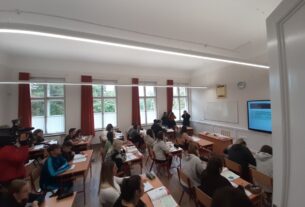More than 126,000 people applied for Hungarian higher education this year – the Minister of Culture and Innovation announced on Monday in Budapest, at a press conference presenting the results of applications for higher education courses.
János Csák said that last year the number of applicants was still 99,000, the increase means that the attractiveness of the higher education training system has increased.
The government’s goal is for a nation made up of “economically strong, culturally confident, self-sufficient families” to live here, in the Carpathian Basin, the minister stated, emphasizing that every policy measure serves this.
János Csák recalled that in the last five years, many changes were implemented in the higher education system, which served to give as many driving licenses as possible to families and young people and at the same time satisfy Hungary’s economic and cultural needs.
The GDP is growing continuously and strongly, and for this, it is necessary to build training structures in the training system that serve the economy, he added.
The minister reminded that this is why they initiated the change of the admission system last year – after many consultations – and why more licenses were given to the universities.
János Csák also highlighted that many more people applied for higher education from disadvantaged districts than before. He called it particularly gratifying that more people applied for the teacher, and kindergarten teacher courses than before.
Explaining the details, Balázs Hankó, the State Secretary responsible for innovation and higher education at the Ministry of Culture and Innovation, spoke about the fact that 126,449 people applied for the renewed Hungarian higher education, within the framework of the now fully electronic admission process.
The renewed admission system increased the number of applicants by 27 percent. In addition, 100,000 prospective students who do not have a degree applied. The latter number is 26,000 more than last year, i.e. the number of applicants who do not yet have a diploma increased by 34 percent, exceeding the average, he said.
The state secretary said that every fifth applicant wants to enter the technical, natural sciences, mathematics or IT fields. The increase was also strong in the case of older people: 32 percent more people applied. The oldest applicant is 75 years old and wants to study German studies.
Balázs Hankó also touched on the fact that the popularity of rural higher education institutions has increased: the number of applicants to Nyíregyháza University has increased by 60 percent, and to Miskolc University by 40 percent, but an above-average number of students want to enter the institutions in Dunaújváros, Sopron and Veszprém.
The state secretary emphasized that eleven universities in Hungarian higher education are in the “elite league”, i.e. in the top five percent of universities in the world.
After the press conference, János Csák responded to the questions raised in recent months at the background discussion on the topic, and spoke about the fact that the dropout rate in higher education is decreasing, both for domestic and foreign students. In his opinion, this can be attributed to the fact that the institutions pay much more attention to “student welfare”.
The minister also highlighted that, compared to 2018, the universities achieved an exceptionally good performance, after the number of publications increased.
Also responding to criticism, János Csák said that it was not true that the appointment order of university professors would be “inflated”.
In response to questions, he stated that, in proportion to GDP, Hungary spends on higher education above the European Union average, according to last year and the year before last’s data.
The strategic changes will bring results, and the improvement in higher education can be seen in two years – stated János Csák, adding: the transformation of higher education is one of the biggest successful projects in the last 33 years.
He also stated that the Erasmus program will be financed from its own resources from 2024.
The minister stated that in 2013, the number of foreign students was 13-14 thousand, today it has increased to more than 42 thousand.
Balázs Hankó said at the background discussion that the number of applicants for the bachelor’s program has increased significantly: while 65 percent applied for the bachelor’s program last year, this year this ratio is 70 percent. Furthermore, 74 percent more people applied for higher education from vocational training than last year.
60 percent of applicants are women, and 40 percent are men.
The number of applicants for the first degree has increased to 100,000, compared to 74,000 last year, which represents a 34 percent increase, the state secretary said.
He said that the “changed model” institutions were chosen by the majority (62 percent). The share of church institutions has also increased: last year it was 9 percent, and now it is 11 percent. On the other hand, the proportion of state institutions (currently 23 percent) has decreased.
Most of them (17,829) applied to the Eötvös Loránd University (ELTE), the number shows a 16 percent increase, Balázs Hankó announced.
After ELTE, the University of Debrecen (11,351 applicants) followed by the University of Szeged (9,015).
The state secretary said that the popularity of rural universities has increased: 57 percent of applicants want to enter Budapest and 43 percent want to enter a rural institution, this ratio was 60-40 percent last year.
Balázs Hankó announced that about 6,000 people applied to become teachers this year, compared to 4,400 last year.
According to the published press material, 88,074 people applied for bachelor’s education this year, compared to 63,622 last year. 21,396 people want to enroll in a master’s program, in 2022 this number was 18,193. The number of applicants for undivided training increased from 11,090 last year to 12,232. There were 4,747 applicants for higher education vocational training this year, and 6,285 last year.
The most popular training field this year was economics, with 21 percent.
MTI

















